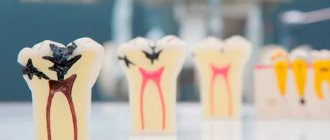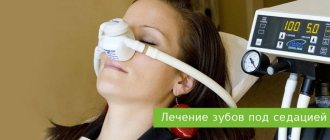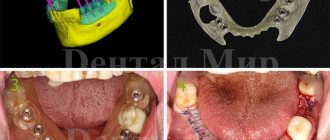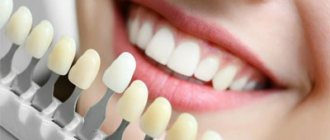Author of the article:
Soldatova Lyudmila Nikolaevna
Candidate of Medical Sciences, Professor of the Department of Clinical Dentistry of the St. Petersburg Medical and Social Institute, Chief Physician of the Alfa-Dent Dental Clinic, St. Petersburg
Inflammation of the gums, or periodontitis, is one of the most common dental diseases. This pathology of the oral cavity can occur due to both chronic diseases and local traumatic injuries.
The main symptom of periodontitis is an acute inflammatory process of gum tissue. Lack of treatment can lead to the development of severe forms of the disease, characterized by tooth loss and displacement.
What is periodontitis?
Periodontitis, or, as it is popularly called, dental periodontitis, is an inflammatory disease of the periodontal tissues that surround the tooth (gums, dental ligament and surrounding jaw bone). In professional terms, periodontitis is an inflammation of the ligaments of the tooth.
Periodontitis can be localized, that is, spread to the area of one or two teeth, or generalized, that is, affect most of the dentition. If a patient has periodontitis, it is usually chronic. Therefore, the main task of a specialist is to identify the cause of the disease, prescribe the correct treatment and, most importantly, prevent subsequent exacerbations and complications.
What is "periodont"
Periodontium is a complex of tissues that includes gums, tooth cement (located around the root), periodontium (a kind of layer between cement and jaw bone), as well as alveolar processes - that is, the upper part of the jaw bone. And if gingivitis is an inflammation of the gums only, then periodontitis is an inflammation of all the tissues that are part of the periodontal complex.
The upper boundary is the soft mucous membrane - the gums. It is from the gums that in 90% of cases the inflammatory process begins, which gradually moves to deeper tissues - to the ligaments and jawbone, which leads to tooth loss. In such situations, the main reason for the development of the pathological process is considered to be nothing more than dental plaque, that is, poor oral hygiene. The remaining 10% are general diseases of the body that lead to disruption of cell nutrition and destruction of bone tissue (for example, osteoporosis, rheumatism, diabetes, leukemia).
Periodontal tissues have many functions: they ensure retention of teeth in the alveoli (sockets) and their shock absorption, distribution of chewing pressure, and provide nutrition (both to the gums and the teeth themselves). In addition, periodontal tissues perform a barrier function, preventing the passage of harmful bacteria both from inside the body into the oral cavity and in the opposite direction - into the area of the jaw bone and lymphatic system.
What are the signs of periodontitis?
The initial signs of periodontitis are bleeding gums when pressing on them or when brushing teeth, bluish or red gums, and bad breath. Already in the later stages of the disease, tooth mobility and visible exposure of their roots appear, which indicates a severe and advanced form of the inflammatory process. When periodontitis becomes chronic, the tissues surrounding the tooth are “reabsorbed” and pathological gum and bone pockets are formed. As a result, the tooth gradually becomes loose and falls out.
It is necessary to distinguish the exposure of roots during periodontitis from the so-called gum recession - a decrease in the height of the gingival margin, as a result of which the root of the tooth is exposed, in other words, “sliding” or gum atrophy. Unlike periodontitis, recession is not caused by inflammation and does not entail the formation of pathological pockets and loosening of teeth. Additionally, in most cases, gum recession can be successfully treated.
Gum recession
One of the manifestations of periodontitis can be gum recession.
This happens when the atrophic component of the disease exceeds the inflammatory component.
And then the gums seem to “retreat” from the neck of the tooth, exposing its root.
The problem is that the tooth root is not designed to exist in such an open state. Therefore, root caries may develop in exposed areas. Another threat to the tooth in such a situation is the occurrence of a wedge-shaped defect, a non-carious lesion in the cervical area of the tooth, which, as the name implies, has a wedge shape, hard walls and, in the absence of appropriate treatment, can progress, becoming deeper and deeper over time and reach literally to the dental nerve.
Gum recession on maxillary teeth
Both caries, a wedge-shaped defect, and simply exposure of the root can lead to sensitivity in the tooth; it will react to temperature stimuli, such as cold or hot air or water, it will hurt when brushing your teeth and chewing an orange, lemon, etc.
Wedge-shaped defect
After some time, as a rule, pain occurs when eating solid food.
But that's not all.
Root exposure means not only recession of the gums, but also retreat of the closely associated bone in which the tooth root is located.
This, in turn, means tooth mobility, which necessarily progresses over time and can lead to tooth removal or even spontaneous loss.
Gum recession and significant exposure of the roots of the anterior teeth
It must be said that this condition can be either generalized, spreading to all or almost all the teeth on one or both jaws, or be local, covering only one or a few teeth.
What are the reasons for the development of gum recession and what modern dentistry can offer to combat this disease, we will tell you in this article.
What are the causes of periodontitis?
Understanding the causes of the disease is a very important point, which helps the doctor correctly determine how to treat gum periodontitis. The disease can be triggered by both general and local factors. Common causes include diseases of the gastrointestinal tract, diseases associated with pathology of the endocrine system, some gynecological and urological diseases, sexually transmitted infections, and a weakened immune system. Local, or local, factors are missing teeth, malocclusion, incorrectly installed fillings or crowns, which mechanically irritate the gums and create conditions for the accumulation of bacterial plaque. A significant role is played by the specific microbial flora of the oral cavity, which occurs in some patients and causes periodontitis. But the main factor in the development of periodontitis is poor oral hygiene.
Causes of periodontitis
Dentists say the main culprit in the occurrence of periodontitis is bacterial plaque. If you do not remove it from the surface of your teeth in time, over time it hardens and turns into tartar. It, in turn, contributes to the formation of a gap between the gum and tooth, which is commonly called a periodontal or periodontal pocket. As a result, it becomes increasingly difficult to maintain oral hygiene: food debris gets clogged into the resulting gap and provokes an inflammatory process.
The rapid formation of tartar is not necessarily a sign of poor hygiene. The cause of the pathological process may be reduced secretion of saliva, which naturally cleanses the oral cavity. This problem often occurs during long-term use of antidepressants and anti-inflammatory drugs.
The disease can also develop due to a lack of vitamins and microelements. Thus, a lack of calcium will certainly affect the entire skeletal system of the body, and a deficiency of vitamin C reduces the strength of connective tissue. In adults, periodontitis can be a payback for the habit of chewing on one side and a dislike for solid foods: raw vegetables and fruits - ideally, the load on the teeth should be even, and the gums need daily training.
How is periodontitis diagnosed?
It is possible to determine whether a patient has periodontitis or not already at the first appointment, focusing on his complaints and the condition of the oral cavity. Moreover, when diagnosing the disease, special tests are used, the most popular of which is the Parma index. It works as follows: a special Schiller solution is applied to the gums, which reacts to unhealthy tissues and colors them in a bright color, revealing the source of inflammation. There is also an index that determines the level of bleeding, and a Russell test that reveals the condition of not only the gums, but also the bone tissue.
X-ray studies, which determine the degree of the disease that has arisen, are the main ones in the diagnosis of periodontitis. For such a study, you can use a radiovisiograph (a device for conventional targeted X-rays), or an orthopantomograph (an extraoral device that can take a picture of both jaws at once). However, the most informative method is considered to be extraoral cone-beam computed tomography, which allows layer-by-layer examination of each piece of the jaw and tooth in three-dimensional format.
Currently, the Florida probe computer diagnostic technique has appeared, which allows you to most accurately determine and record the depth of periodontal pockets - the main pathological manifestation of periodontitis. The examination is easily tolerated by patients and helps the doctor prescribe appropriate treatment.
For periodontitis, a microbiological study is also carried out, with which you can study the microflora of the oral cavity and determine the sensitivity of microorganisms to antibiotics for a more accurate selection of drug treatment.
Another mandatory test is a blood test. It allows you to identify the cause of the disease, which may be either the initial stage of diabetes or a chronic infectious process in other organs and systems, as well as disorders associated with hormonal levels and metabolism.
In the process of diagnosing periodontitis, consultation with related specialists is often required to identify and treat concomitant diseases.
Periodontitis - symptoms and treatment
At any stage of the disease, treatment begins with the removal of dental plaque, microbial biofilm, soft plaque and tartar.
Tartar is removed with ultrasound, subgingival calculus is removed with special curettes. Soft and pigmented plaque is removed using the Air Flow device - it allows you to return the enamel to its natural shade. Next, all surfaces of each tooth are polished and ground with special pastes and brushes.
The procedure ends with antiseptic treatment of the gums and applications of anti-inflammatory balms.
Anti-inflammatory therapy is carried out after professional oral hygiene and before other medical procedures (for example, curettage of periodontal pockets, vestibuloplasty).
The mild stage of periodontitis begins to be treated with local antiseptics (in the form of gels, ointments, mouth rinses), in more severe cases - with antibiotics, antifungals and hormonal drugs.
If the depth of periodontal pockets is more than 5 mm, additional surgical intervention . Perform deep cleaning of periodontal pockets from subgingival stones and pathological tissue through dissection or without dissection of the gums. Sometimes gingivectomy is performed - excision of periodontal pockets, including their treatment with curettes and removal of necrotic tissue.
A prerequisite for the treatment of periodontitis is:
- prosthetics;
- restoration of missing teeth;
- correction of bite pathologies;
- elimination of orthodontic problems of the oral cavity;
- treatment of caries.
Elimination of defective fillings and prosthetics
During the treatment of the disease, the overhanging edges of fillings in the area of interdental spaces are removed. A very important point is the removal of low-quality crowns that are deeply buried under the gum (this arrangement of artificial crowns contributes to the deepening of the periodontal pocket), as well as ill-constructed dentures.[9]
Treatment of periodontitis with laser
The essence of this therapy is the introduction of a laser LED into the periodontal pocket. A laser is used to remove pathological tissue.
After treatment, the sterile clean periodontal pocket is closed, thereby preventing the penetration of pathogenic microorganisms.
In the early stages of periodontitis, sometimes one procedure is enough. For advanced forms of the disease, several sessions are performed. They are performed once a week.
To eliminate periodontitis with a laser, various types of beams are used (CO2, diode or neodymium).
The main advantages of laser treatment:
- bloodlessness of the treatment method - laser radiation during procedures literally seals all small vessels;
- painlessness - during laser treatment, anesthesia may not be required, since the patient does not experience significant discomfort;
- quick rehabilitation - immediately after the procedure the patient can return to their normal lifestyle;
- minimal number of contraindications - laser treatment is indicated for small children, pregnant women, and allergy sufferers.
Plasmolifting
Periodontitis can be treated by local injection of plasma obtained from the patient’s blood into the damaged soft tissues of the oral cavity.
During plasmolifting, gum cells are stimulated, resulting in their natural regeneration. Under the influence of platelets and leukocytes contained in plasma, inflammatory processes are stopped.
Indications for plasma lifting:
- gingivitis;
- periodontitis grade 1-3;
- periodontal disease;
- inflammation of the walls of the socket after tooth extraction;
- inflammation of bone and soft tissue around the implant;
- healing of soft tissues after dental operations;
- prevention of gum disease.
The plasma lifting procedure is a unique technique that has no analogues. It is based on the use of PRP therapy technology. In dentistry it is called Plasmodent.
Laser treatment is indicated for patients who have symptoms of inflammatory or atrophic diseases of the oral mucosa. In addition, it is used to activate and significantly accelerate the restoration of bone tissue after implantation or osteoplastic surgery.
The main task of plasma lifting is to stop the development of the inflammatory process of periodontal disease and activate the natural restoration of the gums, its structure, color, and also prevent the destruction of bone tissue.
How is periodontitis treated?
Successful treatment of periodontitis can only be achieved in a well-coordinated team of “doctor plus patient”. Much depends on the doctor, but even more depends on the patient himself. The doctor is responsible for the treatment, and the patient is responsible for maintaining the result, because periodontitis is a chronic disease.
Treatment methods for periodontitis are divided into medicinal and surgical. In case of minor inflammation caused by dental plaque, the doctor thoroughly cleans the teeth, eliminates conditions that contribute to the retention of microbial plaque, polishes the surfaces of the teeth and applies a therapeutic bandage with medication to the inflamed area. If a deep periodontal pocket forms and severe pain occurs, the patient may be prescribed antibiotics. When treating severe periodontitis, it is necessary to resort to more serious (surgical) procedures, such as curettage and flap operations. But in any case, periodontitis requires complex treatment, including professional hygiene, drugs for local and internal use, and, if necessary, surgical procedures.
There is also a hardware method for treating periodontitis - Vector. The method involves using ultrasound in combination with medications aimed at fighting microbes and stimulating healing. The Vector device is used both as an independent technique and in combination with surgical treatment.
Drug treatment of periodontitis
The next stage of treatment is to relieve inflammation and eliminate bleeding gums to prevent further development of the disease. This goal is achieved through drug therapy.
Medicines for the treatment of periodontitis are divided into local and general:
- local remedies are used to treat the affected areas. This includes rinses, antiseptic solutions, anti-inflammatory gels and balms. Local treatments also include therapeutic and prophylactic toothpastes, which can be used as an addition to the main therapy;
- general drugs, which are combinations of antibiotics in the form of tablets or intramuscular injections.
Non-invasive treatment for periodontitis may also include physical therapy. Auxiliary procedures using laser or electrophoresis will help eliminate inflammation faster.
What are the surgical treatments for periodontitis?
Surgical treatment of periodontitis is important in the later stages of the disease with severe tooth mobility and deep periodontal pockets. This is, first of all, a curettage procedure, which involves removing dental plaque and pathological granulation tissue from under the gums. If the depth of the periodontal pocket is up to 4 mm, closed curettage is performed without opening the gum; if it is more, open or flap surgery is performed, when it is necessary to detach the periosteal flap, fold it back and clean out the pocket. This procedure is always performed with pain relief and is well tolerated by patients.
In addition to the procedures described above, splinting is performed for periodontitis, which secures loose teeth.
Types of periodontitis
To select an effective treatment, the dentist must first determine the causes of periodontitis and identify the nature of the disease. Therefore, the classification of periodontitis is not so much of scientific interest as it contains the ability to predict the further development of the situation and select those treatment methods that will give the best result.
One or another type of periodontitis can be diagnosed based on 3 criteria: severity, course of the disease and localization of the process.
By severity
To determine the severity of the disease, dentists evaluate the depth of the periodontal pocket, tooth mobility and the degree of bone tissue resorption:
- with mild periodontitis,
the teeth are immobile, the depth of the periodontal canal does not exceed 3.5 millimeters. The height of the interdental septa is still slightly reduced: no more than one third of its length; - with moderate periodontitis,
the height of the interdental septa is reduced by half its length, the periodontal pockets deepen to 5 millimeters, and the teeth begin to slowly shift; - Severe periodontitis
is visible to the naked eye even when talking to a person. The teeth are displaced and gaps form between them. And the patient complains of severe pain, bleeding, and sometimes the discharge of pus from the periodontal canals.
Severe periodontitis is statistically observed in 15-20% of people over 35 years of age.
With the flow
The course of the disease can be acute or chronic. The acute form of periodontitis is very rare and does not affect the entire oral cavity, but a small area of the gums. It occurs as a result of injury to soft tissues as a result of an impact, an incorrectly installed crown, or a broken piece of tooth.
Acute periodontitis develops at lightning speed and causes severe pain, with which the patient usually rushes to the dentist. The chronic process is characterized by a wave-like course and coverage of the entire oral cavity. When the disease enters the remission stage, the patient mistakenly believes that he is completely cured. But after a few months everything repeats itself, and this time the signs of inflammation will be more pronounced.
With timely consultation with a doctor, acute periodontitis can be cured quickly and effectively. If periodontitis has entered the chronic stage, the prognosis is less favorable.
By localization
Depending on how extensive the area is covered by the pathological process, periodontitis is distinguished:
- localized
or
focal
; - generalized
.
In the first case, the disease manifests itself in only one or several teeth. And dentists talk about the activation of secondary factors. This means that the development of periodontitis could be triggered by a poor-quality filling, contact with arsenic paste or filling material on the gums, careless installation of a prosthesis, and even injury to the gums by dental floss.
In the generalized form of periodontitis, the gums, connective and bone tissue on two rows of teeth are affected. This is typical for the chronic course of the disease, which is much more difficult to treat.
Is it possible to eliminate periodontitis with a laser?
Laser treatment of periodontitis is one of the most effective and minimally invasive ways to combat the disease, which is one of the stages of complex treatment. The laser has cleansing and antibacterial properties. During the procedure, each periodontal pocket is treated for a certain time, sufficient for the laser light beam to destroy pathogenic bacteria. The procedure is bloodless and virtually painless. However, a good effect can only be obtained with an integrated approach to the treatment of periodontitis.
Is it true that periodontitis can be cured with implantation?
Implantation is a method of combating not periodontitis itself, but its consequences. At a later stage of the disease, teeth become loose and fall out, so they have to be replaced with implants. It should be understood that dental implantation for periodontitis has its own difficulties and limitations, since bone tissue is absorbed in this disease. Its sufficient volume is the main condition for successful installation of implants. If periodontitis is in an advanced stage, implantation can be very difficult or even impossible due to a lack of bone volume. That is why patients should begin treatment as early as possible in order to do everything possible to preserve their teeth, and if they are lost, do not miss the opportunity to restore them with implants.
In any case, before installing implants, it is necessary to transfer periodontitis to the stage of remission (stabilization) or, if possible, eliminate the cause of its occurrence.
Symptoms of periodontitis
The onset of periodontitis is almost invisible to the patient. Few people consider itching in the gums, minor discomfort during chewing and bad breath to be a good reason to visit a dentist. Patients begin to think about the need for treatment later: when the gums begin to bleed, react painfully to brushing their teeth, become inflamed and swell. If no action is taken at this stage, the teeth will soon begin to loosen. Advanced periodontitis can no longer be ignored. It is characterized by: increased body temperature, inability to chew due to sore gums, displacement and loss of teeth.
What consequences can untreated periodontitis lead to?
Loss of teeth
The advanced stage of the disease destroys the soft and hard tissues around the teeth, which leads to their loss.
Deterioration of conditions for implantation
As mentioned earlier, with severe periodontitis, the volume of the jaw bone is significantly reduced, which makes it difficult to install implants, requiring preliminary bone growth, and in extremely severe cases makes implantation impossible.
The occurrence of other diseases
Periodontitis contributes to diseases of the gastrointestinal tract, diseases of the lungs, heart and even the formation of blood clots.
How to avoid further exacerbation of the disease?
This is where the patient becomes the main member of a well-coordinated doctor-patient team. To maintain the results obtained after treatment of periodontitis, you should brush your teeth correctly and regularly, following all the recommendations of the treating dentist, since with periodontitis, individual oral hygiene differs from usual. In particular, along with a regular brush and paste, there is a need to connect additional hygiene products: dental floss, various brushes for teeth, an irrigator, etc.
In addition, it is necessary to come to the dentist for professional cleaning at least once every six months, and for people with chronic periodontitis even more often - once every three months. Good hygiene is an excellent prevention of periodontitis and the only way to maintain the results of treatment.
How much does it cost to cure periodontitis? What does the cost consist of?
The price for periodontitis treatment depends on the complexity of the disease, whether surgical procedures will be performed and to what extent.
Important!
Folk remedies in the form of all kinds of herbal infusions do not help with periodontitis. They can bring temporary relief and mask the problem, but mouth rinses cannot radically solve it. Neither home treatment nor the miraculous toothpaste from TV commercials will help get rid of periodontitis. Rinses and toothpastes are just one of the auxiliary components in complex treatment. If you have periodontitis or suspect it, contact the dentist for timely diagnosis, since it is in the early stages of the disease that doctors have a lot of opportunities to help you!
Treatment with medications at home
Treatment of periodontitis is always complex. But if surgical methods are not indicated for everyone and not always, and they are increasingly being replaced by hardware procedures, then drug therapy is a mandatory element of treatment. It includes the following:
- antiseptics;
- steroidal and non-steroidal anti-inflammatory drugs;
- immunomodulatory agents.
It is impossible to cope with periodontitis on your own at home! No miraculous toothpastes, magic toothbrushes or even injections will help if you do not eliminate the main cause of inflammation - bacterial plaque and tartar. Therefore, the medicinal method of treating periodontitis will bear fruit only after the dentist has cleaned the teeth, and, if necessary, undergone surgical intervention.
In almost all cases, dentists insist on treating periodontitis with antibiotics. They can be local, in the form of ointments or gels. But more often, broad-spectrum drugs are prescribed: Trichopolum, Doxycycline, Metronidazole. It is recommended to take them in the form of tablets; less often, the dentist may recommend injections.








